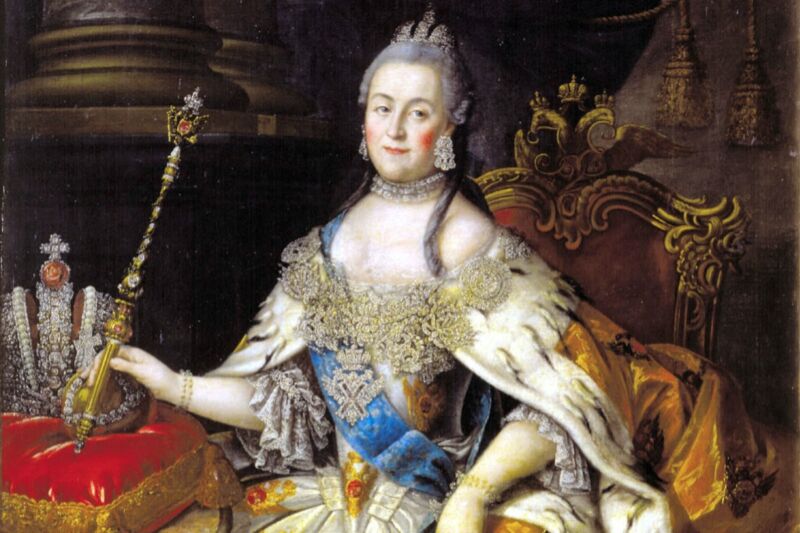That time Catherine the Great championed smallpox vaccinations
[ad_1]

During her long reign, Catherine the Great‘s leadership transformed Russia into a powerhouse of Europe. She was also a leader in public health policy, championing a nation-wide vaccination campaign against smallpox at a time when many viewed the practice with distrust. A letter by the Empress outlining her inoculation strategy is up for auction by MacDougall’s in London. Included in the sale is a portrait of the monarch as the “Lawgiver in the Temple of Justice,” painted by Dmitri Levitsky, who was a favorite of the Russian court in the 1770s and 1780s. The two items are expected to sell for as much as $1.6 million.
As we’ve reported previously, the World Health Organization declared smallpox to be an eradicated disease in 1979, and many people don’t remember just how devastating it could be. It began with a high fever and severe vomiting, followed by a skin rash. The victim would next develop sores, which eventually scabbed over and fell off, scarring the skin. About three in ten of those infected died, and the survivors were typically badly scarred for life, sometimes even blinded or permanently disabled.
The Chinese were inoculating people against smallpox as early as the 1500s. European physicians in the early 18th century relied upon variolation (the use of smallpox to induce immunity) to control the spread of smallpox, in which scrapings from smallpox pustules were scratched into a person’s arm or inhaled through the nose. While those who received the treatment did go on to develop common smallpox symptoms like fever and rash, the death toll was significantly lower.
By the late 1700s, a handful of physicians in England and Germany noticed that people infected with the milder cowpox seemed to be immune to smallpox, and there were a couple of early vaccination tests in humans. For instance, in 1774, a farmer in Dorset, England, named Benjamin Jesty, successfully vaccinated his wife and children with cowpox. But it was the English physician Edward Jenner who is credited with bringing the smallpox vaccine into mainstream medical practice, after giving a cowpox inoculation against smallpox to the son of his gardener in May 1796.
Catherine the Great’s letter to Count Petr Alekandrovich Rumiantsev is dated April 20, 1787, and hence predates Jenner’s medical breakthrough by nearly ten years. The monarch had a longstanding horror of smallpox dating back to her childhood, and her husband, Grand Duke Piotr Fedorovich, contracted the disease on the day before their wedding, leaving him permanently disfigured.
-
First page of letter from Catherine the Great to Count Piotr Aleksandrovich Rumiantsev on vaccination against smallpox, April 20, 1787.
MacDougall Arts -
Second page of the Russian monarch’s letter calling for smallpox vaccination campaign.
MacDougall Arts
So naturally Catherine feared for her son’s health when another outbreak of smallpox hit. She was advised to inoculate her son (and heir), Pavel Petrovich, but felt it would be “shameful not to start with myself.” This made her remarkably enlightened for the age, when even many Russian doctors opposed the practice. Catherine invited an English physician named Thomas Dimsdale to St. Petersburg, since he had inoculated the entire British Royal family and aristocracy against smallpox. She made sure to have a mail carriage ready for Dimsdale to make a speedy escape should the experiment go wrong and Catherine succumb to the disease, incurring the wrath of her people.
Dimsdale harvested the contents of a smallpox pustule from the young son of a sergeant-major, and used it to inoculate Catherine. She experienced one week of mild discomfort, but announced her full recovery on October 29, 1768. Her son was inoculated soon after. “Starting with me and my son, who is also recovering, there is no noble house in which there are not several vaccinated persons,” she wrote in a letter to Count Ivan Grigorievuch Chernyshev, her ambassador in Britain. “Many regret that they had smallpox naturally and so cannot be fashionable.”
Unfortunately, the fashionability of being vaccinated against smallpox amongst the nobility did not trickle down to the Russian population at large, particularly in the outer regions of the empire. That’s what prompted Catherine’s 1787 letter to the count outlining a strategy for a nationwide vaccination campaign. Here’s the text of the letter:
Count Piotr Aleksandrovich, among the other duties of the Welfare Boards in the Provinces entrusted to you, one of the most important should be the introduction of inoculation against smallpox, which, as we know, causes great harm, especially among the ordinary people. Such inoculation should be common everywhere, and it is now all the more convenient, since there are doctors or medical attendants in nearly all districts, and it does not call for huge expenditure.
To set an example of this, issue an order on the first occasion in each provincial town, to count the remaining superfluous conventual residences or the small monasteries that have been abolished, and build the minimum number of lodgings for the temporary stay of those who are unable to have this inoculation at home; money needed for this could be borrowed from town revenues. Provincial doctors can put this matter right, especially since now there are people sent from us who have a low salary against the regulations: so, since Dr Gund in Novgorod-Seversky can successfully carry out this inoculation, then add three hundred rubles to his regular salary from the remaining income from the former monastery estates. We remain, by the way, favourably disposed towards you.
The letter is signed “Iekaterina.”
[ad_2]
Source link




